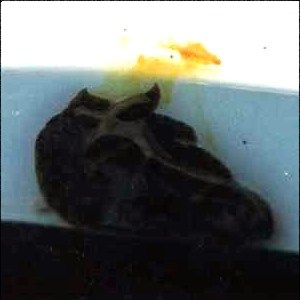

Yellow gland - Aglajidae
PHOTO
UPPER: Yellow Ink being expelled from Navanax aenigmaticus, Caribbean coast of Colombia, 2.5 cm long. Photo: Elianny Domínguez Tejo.
LOWER: Anatomy of Navanax inermis showing position and size of Yellow Gland [Rudman, 1974 -Fig 8].
This gland is unique to the Aglajidae and found in all genera. I named it the Yellow Gland to be consistent with the Aplysiid Purple Gland though there is no suggestion that the two glands are homologous.
It is a large gland sac sitting in the posterior end of the body cavity and opening just to the left of the anus into the mantle cavity. It releases a bright yellow secretion on some occasions when the animal is disturbed. To test the nature of the yellow secretion I collected it from the New Zealand aglajid Melanochlamys cylindrica and placed it in a watch-glass of fresh sea water. Polychaete worms, up to 50mm long, the normal food of this species, were paralysed in a few seconds if placed in this solution but would recover if removed within 30 seconds. They would die within 2-3 minutes if left in the yellow gland secretion. However as I said then (Rudman, 1972) we must be cautious in suggesting either an offensive or defensive function to the gland. The secretion is only produced sometimes, and since the mantle cavity is at the rear of the body it would not be much use in primary defence or for stunning potential prey. I suspect it is an excretory product with no direct function.
• Rudman, W.B. (1972) On Melanochlamys Cheeseman, 1881, a genus of the Aglajidae (Opisthobranchia: Gastropoda). Pacific Science, 26(1): 50-62.
• Rudman, W.B. (1974) A comparison of Chelidonura, Navanax and Aglaja with other genera of the Aglajidae (Opisthobranchia, Gastropoda). Zoological Journal of the Linnean Society 54(3): 185-212.
Rudman, W.B., 2001 (June 8) Yellow gland - Aglajidae. [In] Sea Slug Forum. Australian Museum, Sydney. Available from http://www.seaslugforum.net/factsheet/yellink
